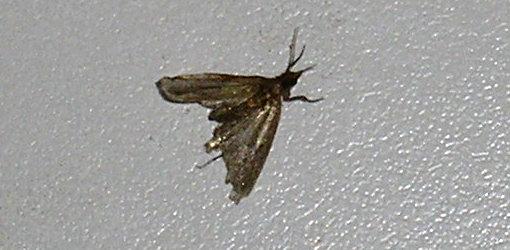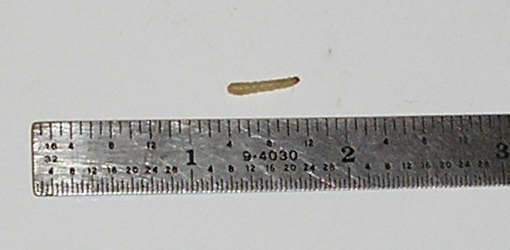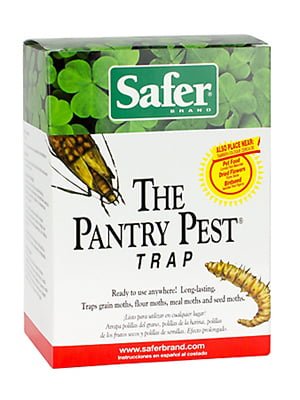How to Get Rid of Moths in Kitchen Cabinets

Pantry moths may look small, but they can cause big problems in your kitchen.
My pantry has been invaded by little worms and moths that appear to have come from a bag of birdseed. What are they, and what should I do?
It sounds like your pantry has been infested with Indian meal moths, also known as pantry moths. The tiny, nearly-invisible eggs come into your house in food packages, and they can hatch into larvae which later turn into moths that wreak havoc on your foodstuffs. Indian meal moth eggs are often present in:
- Bird seed
- Cereals and grains
- Flours and meals
- Dried fruit
- Pasta
- Candy
- Pet food
- Dried herbs
- Nuts
- Powdered milk
How To Identify Pantry Moths
If you see any of the following, you could have Indian meal moths:
-
- Larvae in Food: Nothing's creepier than pouring out some cereal and it starts to move! When the eggs hatch, the larvae will spin webs in the infested food. You'll see the clumps of webbing and the little whitish worms. They start out really tiny but can grow to 2/3" long with black or brown heads. You may also see tiny cast-off skins after the worms have moved away.
-
- Larvae in Home: Look for the larvae moving about or hanging from the walls, often near the ceiling. They're looking for a nice dark crevice to pupate and turn into moths.
-
- Cocoons: You may also see the webby cocoons on top of cabinets and in corners.
- Flying Moths: You may find the small, half-inch long, brownish moths flying around your kitchen and pantry, usually around lights at night.

Pantry (Indian meal moth) larvae infest food and resemble small worms.
How to Control Pantry Moths
If you've spotted Indian meal moths in your pantry, you need to take the following action right away, since they can reproduce several times in a year and will invade the rest of your pantry:
-
- Eliminate Source: Find out which package brought in the infestation, wrap it tightly in a plastic bag and throw it away immediately.
-
- Thorough Cleaning: I can't emphasize enough how thoroughly you need to clean your pantry! You will need to:
- Throw away all grains.
- Throw away any food packages that can't get wet (like, boxes and bags) – the moths will lay eggs in any crevice, including the folds of packages. If the infestation is severe, or if you're having trouble getting rid of them, just go ahead and throw away everything.
- Remove and throw away shelf liners.
- Wash all unopened jars and cans in hot, soapy water. Use a toothpick to check for eggs or larvae in the cracks around the lids of jars.
- Wash the inside of the pantry or cabinet with soap and water, then with a weak bleach solution.
- Rinse with a mixture of water, vinegar, and peppermint oil to kill eggs and repel moths.
- If you have adjustable shelves or pegboard, grab a toothpick and clean out the little peg holes! Those are notorious for collecting moth eggs and webs.
- If you used a vacuum cleaner, immediately change the vacuum bag and clean your vacuum.
- Finally, take out the trash and recyclables, and clean your trash can and recycle bins.
- Thorough Cleaning: I can't emphasize enough how thoroughly you need to clean your pantry! You will need to:

-
- Pheromone Traps: Sticky traps, such as Safer Pantry Pest Traps, emit a scent that attracts male moths. While they won't eliminate all of them, traps can help, and give you a way to monitor the infestation.
-
- Treat Suspect Food: I'm inclined to trash anything that looks suspicious, but you can also treat foods by baking them in the oven for one hour at 140° F or higher, or popping food in the microwave on high for 5 minutes, or bagging food and putting it in the freezer for a week.
-
- Avoid Sprays: Pesticides should not be used near food products.
- Give It Time: If the infestation is severe, it can take up to six months to get rid of all the moths and hatching larvae around your house. Hold off on restocking your pantry (beyond what you need short-term) until you're sure they are gone.
How to Prevent Future Infestation of Pantry Moths
-
- Organize Pantry: Get rid of packaged food products that are past the expiration date.
-
- Store Smart: Buy only small quantities of grain products, and store them in airtight, rigid, bug-proof containers (not plastic bags). This makes the occasional infestation a snap to clean up and prevents pantry disaster. Also, store large sacks of pet food and bird seed in airtight containers in the shed or garage rather than the kitchen.
-
- Shop Smart: Buy only the quantities of grain products that you think you can use within a few weeks.
-
- Freezer Treatment: When I buy flours, rice, and other grains that might sit in the pantry for a while, I come straight home from the store and pop them in the freezer. A week or so is long enough to kill off any eggs, and since doing this, I have not had any problem with pantry moths.
-
- Clean Jars and Cans: My husband always washes unopened jars and cans, after reading a study about the amount of bacteria (and worse) that gets on them in warehouses. This practice can also help wash away pantry moth eggs.
-
- Refrigerate Food: If you have space, keep all seldom-used grain products in the fridge or freezer until needed.
- Bay Leaves: Bay leaves are said to be a natural moth repellent. A few leaves scattered around your pantry or cabinets might just help keep the critters at bay (ha!).
Further Information
- Indianmeal Moth (Ohio State University Fact Sheet)

How to Get Rid of Moths in Kitchen Cabinets
Source: https://todayshomeowner.com/how-to-get-rid-of-pantry-moths-and-larvae-in-your-kitchen/
0 Response to "How to Get Rid of Moths in Kitchen Cabinets"
Post a Comment